For restaurants, cafés, bars and foodservice operators, transforming your business to become sustainable is not an easy process and the route taken is a little different for everyone. The good news – there are many ways to minimise your environmental impact and reviewing your recipe’s ingredients is one route to explore.
Using Foodprint data, let’s take a look at how a few swaps and small changes can make a big difference to the footprint of the food you serve.
Full English Breakfast
From its humble beginnings as a way of keeping workers sustained during the day, the Full English Breakfast has become a cultural icon and a symbol of traditional British cuisine. It’s a staple, in one form or another, on breakfast menus across the country, from traditional cafés to trendy brunch spots.
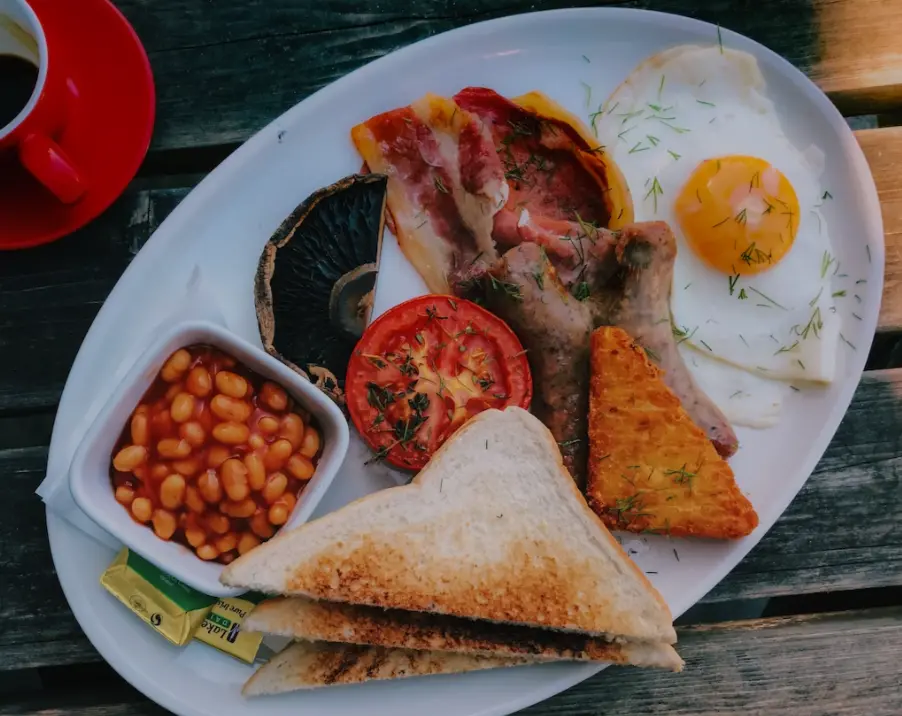
The below is the ingredient list for the Full English our Nutritics chefs created:
- Pork sausages x2
- Bacon rashes x3
- Fried Eggs x2
- Sourdough bread and butter
- Fried black pudding
- One large hash browns x2
- Baked beans – 2.25 tablespoons
- Fried white pudding
- Portobello mushrooms, grilled
The above has a high impact of 2.78kg of CO2eq (carbon dioxide equivalent) per serving – which is an E on the Foodprint scoring system. It requires 3,108 litres of water to produce the ingredients involved – factoring in the farming and agriculture process.
However, with a few tweaks, the environmental impact of this recipe can be lessened:
- Two thick sausages that were fried in vegetable oil were replaced with one thick sausage that was grilled.
- Three bacon rashers that were fried in corn oil were replaced with two reduced salt bacon rashers that were grilled.
- Two fried eggs were replaced with one poached egg.
- The black pudding and white pudding were removed and replaced with grilled tomatoes.
- The quantity of grilled mushrooms was increased from 63g to 100g.
- A large hash brown (84g) was replaced with a smaller version (40g).
- 1 slice of sourdough bread was replaced with 2 slices of wholemeal bread.
- The butter was removed from the recipe.
These changes improved the nutrient profile, cost and environmental impact of the dish, whilst still delivering on taste (according to our internal taste panel!) and utilising the core ingredients expected in a Full English.
This reformulated recipe now has a carbon score of 1.19kg of CO2eq per serving, moving down to a D on the Foodprint scale. It’s worth noting that due to the make-up of a Full English, it will always have a higher score, but this demonstrates how a few swaps can make notable improvements when it comes to carbon.
Taking this a step further, if you serve 50 full english breakfasts a day, this change results in a saving of 79.5kg CO2eq per day or 2,385kg CO2eg per month. That is the equivalent of driving 1,289 miles by car – a trip to and from Plymouth to Inverness!
On the water usage front, the reformulated recipe saved 1,668 litres of water, the equivalent of running a shower for 111 minutes!
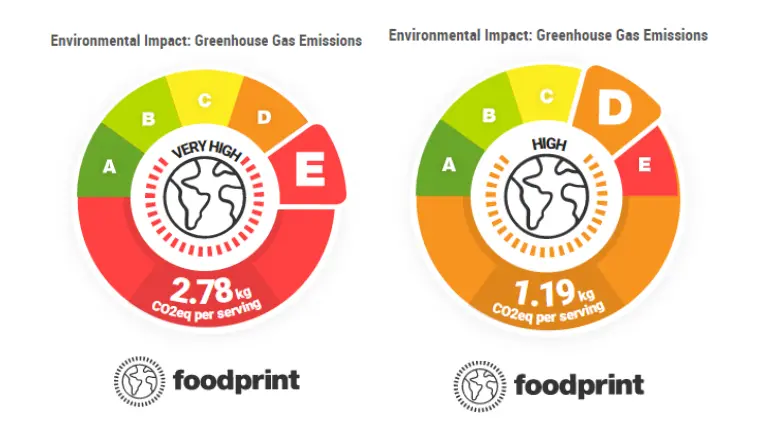
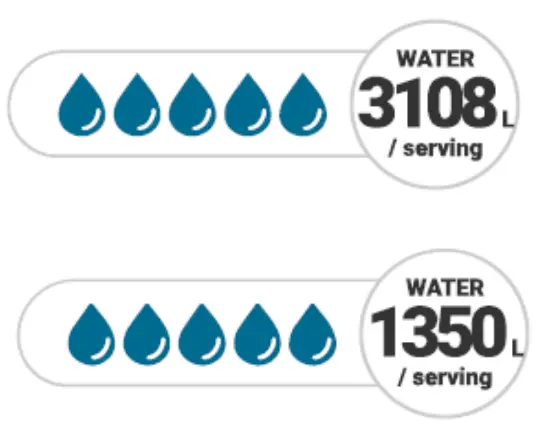
Fish and Chips
Another quintessentially British culinary classic, you’ll likely pick up the scent of this distinctive dish at seaside locations across the country, whilst it’s also a common fixture on pub menus.
Our chefs kept things simple for our original Fish and Chips recipe:
- Original deep-fried thick chips – 500g
- Battered Cod – 257g
- Mushy peas, canned and reheated – 125g
The above dish has a carbon score of 3kg CO2eq per serving (an E on the Foodprint scale) and requires 1,940 litres of water in its lifespan. We challenged our chefs to reduce these figures whilst still delivering on taste, here’s what they recommended:
- The fat used to fry the potato chips was changed from beef dripping to vegetable oil.
- The portion of chips was reduced from 500g to 285g to align with portion size recommendations advised by the UK Seafish body.
- The portion size of cod was reduced from 255g to 150g.
- The quantity of batter was reduced from 320g to 170g.
- Half of the ale in the batter was substituted with sparkling water.
- Processed peas were replaced with frozen peas and the portion size was reduced from 125g to 80g – still contributing to 1 of your 5 a day of fruit and vegetables.
Making these edits reduces the carbon score to 0.95kg CO2eq per serving, moving down to a C on the Foodprint system. That’s the equivalent of travelling 7.95km on the London Underground, whilst it would also take a tree 34 days to absorb the 2.05kg saved in this recipe.
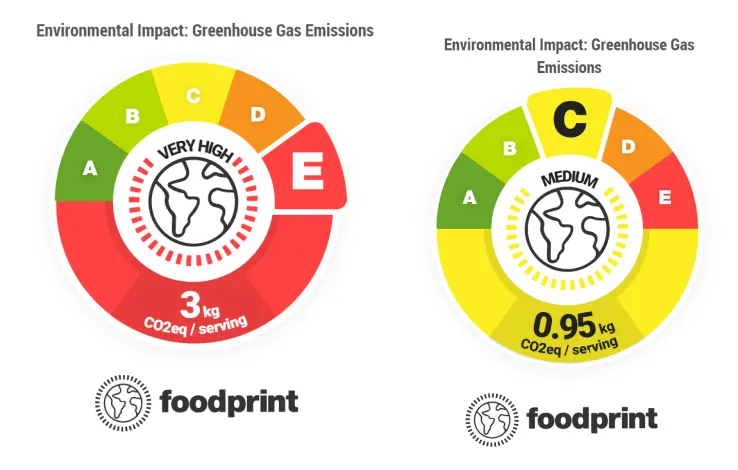
When it comes to water usage, the reformulated recipe saved 1,174 litres, halving the water footprint of the dish.
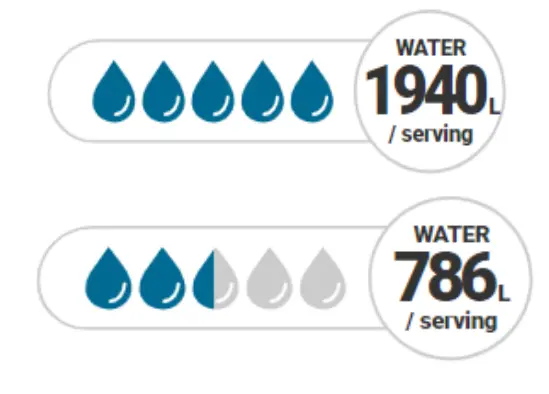
Plenty of food for thought with the above. These are just quick examples of how small and simple changes can have a major impact on the environmental impact of your menu. Foodprint gives chefs and businesses clear data to review so that you can experiment with the make-up of your recipes and giving you a structure to start your sustainability journey.
The software was created to put hospitality and foodservice businesses on a path to more responsible sourcing. With more than three million ingredients in its database, it can provide a credible, evidence-based environmental score for your recipes, covering carbon footprint and water usage.
Whether you publicly showcase the environmental impact scores of your menu items or use the information behind the scenes to inform your decision making, Foodprint can give operators a clearer idea of the impact of their menu and potentially swap out ingredients for lower impact alternatives.
